Magento vs Shopify are currently the two best eCommerce platforms that thousands of e-merchants select to settle in. Despite several weaknesses, both platforms get their names on the score sheet by offering superior functionalities for a feature-rich online store. In this article, I will provide you with a comprehensive Magento vs Shopify comparison guide that will help you decide which one is best for your business.
Keep reading to grasp all the features of Magento Commerce vs Shopify:
- Pricing & Costs
- Themes & Templates
- Ease of Use
- Apps & Extensions
- Marketing Features & Sales Tools
- Payment Options & Transaction Fees
- Reports & Analytics
- Help & Support
- Other Functionalities
Let's get in!
Overview of Magento vs Shopify
Magento is a powerful open-source eCommerce platform that provides a flexible and scalable solution for building online stores. It also has a paid version: Magento Commerce (Magento Commerce Cloud or Adobe Commerce Cloud), which is a comprehensive solution for larger businesses with advanced needs. It provides all the features and functionality of Magento 2 Open Source but offers additional and exclusive capabilities and support.
Meanwhile, Shopify is a hosted solution that allows small businesses to create and manage their online stores easily. Shopify's core value lies in its ability to allow anyone, regardless of technical expertise, to create and manage an online store. And if you're a bigger business, Shopify Plus is an enterprise plan for Shopify's larger and high-growth businesses.
Below is a brief on the key differences between Magento Adobe Commerce vs Shopify:
 |  | |
Overall Rating | ||
Live websites | 120,000+ | 4,900,000+ |
Apps & Add-ons | 4,400+ | 8,000+ |
Themes & Prices | 9* (Free – $499) | 200+ (Free – $450) |
Subscription Fee *Monthly | Free to download (hosting & extensions fee are around $5000) | $39 - $2,300 |
Marketing Features & Sales Tools |
|
|
Payment Options |
|
|
Reports & Analytics | Flexible & specific reporting and analytics capabilities | Advanced Shopify Analytics tools |
Support | Email, Phone, Training, User Community, Help Center | Email, Phone, Live Support, Ticket, Community forum, Help Center, API documentation, Video tutorials, Professional certified experts |
*With Magento vs Shopify sites, you can also buy themes externally if you want to.
#1. Best for Pricing & Costs: A Tie
How much of your budget are you going to spend on your store? Magento vs Shopify, which one offers a better price for you? We’ll show you the difference between Magento vs Shopify pricing.
Magento Pricing
In fact, Magento doesn't require a monthly subscription. This platform is free to download, install, and set up your store. However, as I was building my Magento store, I discovered that finding a domain and a hosting provider is required to publish your website. Therefore, the price for Magento is flexible depending on your selection.
Besides, if you want to enhance your store's capabilities, you can consider adding several integrations to your website. These apps can be found on Magento App Market, and the price can cost up to $15,000.
Magento Open Source | Commerce Pro | Managed Services | |
Magento license cost | 0 | $22,000–125,000/year | $40,000–190,000/year |
Domain name | $10–400/year | $10–400/year | $10–400/year |
Hosting | From $100/year | From $500/year | 0 |
SSL Certificate | $50–300/year | $5–300/year | $50–300/year |
Theme | $0–10,000 | $0–10,000 | $0–10,000 |
Extensions | $60–600/extension | $60–600/extension | $60–600/extension |
SEO & Marketing | $10,000–40,000/year | $10,000–40,000/year | $10,000–40,000/year |
Payment Integration | 2.9%+ $0.30 | 2.9%+ $0.30 | 2.9%+ $0.30 |
Development | From $1,800 | From $10,000 | From $10,000 |
Maintenance | $50–100/hour | $70–$140+/hour | $70–$140+/hour |
Shopify Pricing
In comparison vs Magento, Shopify pricing is subscription-based. Besides the 3-day free trial, (which can be extended for 3 more months with only $1 each), there are 3 main pricing tiers that you can opt for, ranging from $39 to over $399 per month. Fortunately, this plan includes both domain and hosting fees, so you don't have to worry about purchasing these elements.
Basic Shopify $39/month | Shopify $65/month | Advanced Shopify $399/month | |
Transaction Fees *if not using Shopify Payments | 2.9% + 30¢ USD online 2.6% + 10¢ USD in person 2% 3rd-party payment providers | 2.7% + 30¢ USD online 2.5% + 10¢ USD in person 1% 3rd-party payment providers | 2.5% + 30¢ USD online 2.4% + 10¢ USD in person 0.6% 3rd-party payment providers |
Additional staff accounts *assign & manage staff's activities | — | 5 | 15 |
Custom apps | Standard | API PII access included | API PII access included |
Checkout capacity *automatically manage & operate stores | Standard | Standard | 10x |
Shipping Discount *shipping subsidies with leading carriers | up to 77% | up to 88% | up to 88% |
Duties and import taxes | — | — | fully supported |
Localized selling with custom markets | 3 markets | 3 markets | 3 included + $59/mo per added active market |
For more details, Shopify offers a more affordable set of themes and website templates. While the maximum price for a theme on Magento can range up to $499, Shopify only charges $450 for its best website template. In addition, this website builder asks me for a fairly complicated way to calculate transaction fees based on your subscription plan.
The verdict:
After testing out, it's quite hard to say which platform is more affordable for small businesses because Magento vs Shopify are two completely distinct systems.
From my point of view, as Magento is an open-source platform, the pricing will depend entirely on user needs. Meanwhile, Shopify has fixed-price plans that appear less expensive, but you'll still need to pay for themes and apps.
Best for Themes & Templates: Shopify
One of the first things that many people (including me) care about after budget and ease-of-use problems is how their platform will look. Therefore, the first impression of customers is a really important element, and themes are what allow you to reflect your stunning brand and individuality.
Let's take a look at my independent research on Magento vs Shopify themes!
Shopify Themes
A great thing that I love about Shopify is that it provides a wide range of themes with 200+ options on the Shopify theme store. So it's not my biggest fear that I won't find the perfect theme, but I did take a little step back while looking at the price point. Most Shopify themes cost around $140 – $450, which might be a little costly for some people.

Highlight features:
- The drag-and-drop editor allows you to custom, add, switch, remove, and resize elements of your Shopify theme.
- All the themes are mobile-optimized.
- High loading speed.
- Easily add or create new pages.
- You can change the color palette and images according to your business.
- It allows you to add social media feeds easily.
Want to get more insights into Shopify website templates? Please check out my recommendation of the best Shopify themes to find a suitable design for your website.
Magento Themes
Magento themes offer 9 fully responsive themes, which charge you up to $499. With Magento, you can even create your theme from scratch. But just like OpenCart, this requires you to have deep coding knowledge or a budget big enough to hire help.
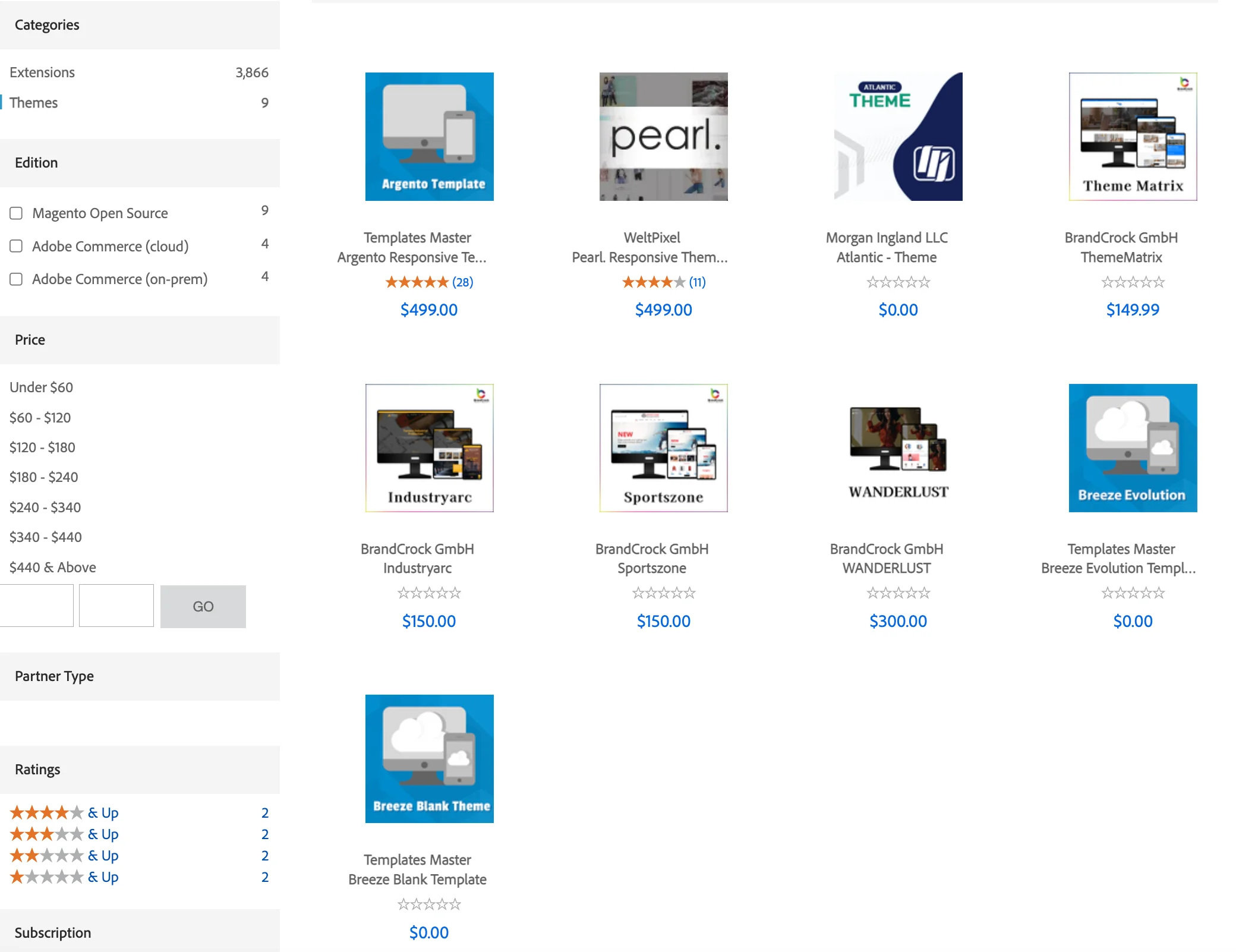
Highlight features:
- It offers more flexible customization (as long as you have a firm technical foundation);
- It allows you to add animations to make your store engaging;
- Add a featured product slider to your homepage;
- You can incorporate newsletter options in your webpage footer;
- Place “cross-selling blocks” on your product pages.
The verdict:
So, Shopify or Magento? In my opinion, Shopify offers a wider range of themes in the fight vs Magento. Plus, I don't even need to utilize code to customize Shopify themes, making it simpler to have a custom design for your stores.
Best for Ease of Use: Shopify
The majority of e-merchants who set up an online business aren't web designers or developers. Even users who are familiar with basic principles want an easy-to-set-up and operate platform.
Let's explore how Shopify vs Magento 2 compare in terms of usability.
Magento Ease of Use
Between Shopify vs. Magento, I must say Magento is much less user-friendly, especially for people without a tech background. While it gives users full control over their website, setting up an online business requires good technical knowledge.
Magento’s open-source framework lets developers create a fully customized experience for different business needs. However, this flexibility makes it more complex to use.
But as you get into the Magento dashboard, the management dashboard may get much easier:
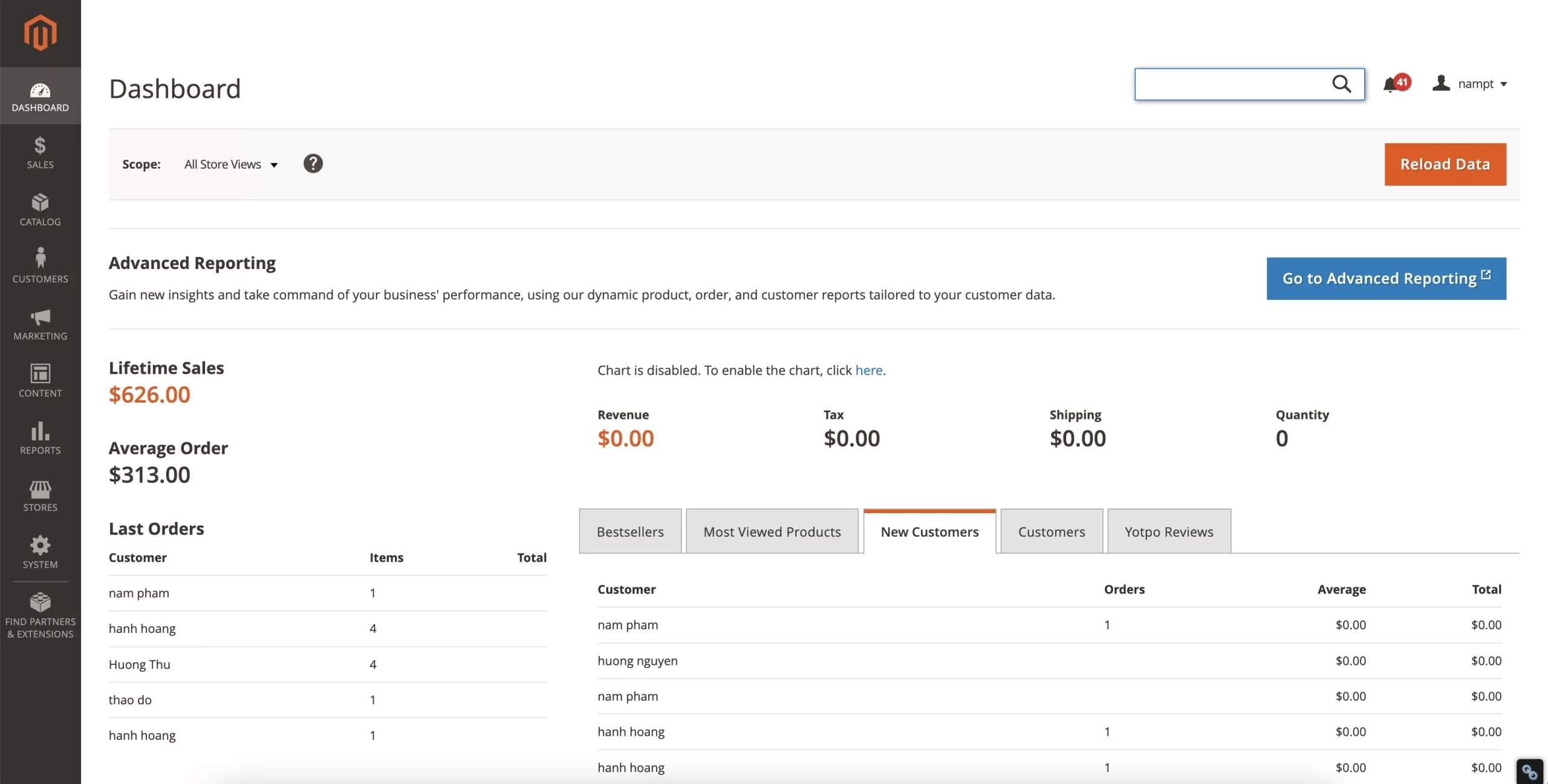
Shopify Ease of Use
On a different note, Shopify clearly holds leverage in this Magento vs. Shopify showdown. Thanks to the nature of a hosted platform, this eCommerce solution is quite easy to use.
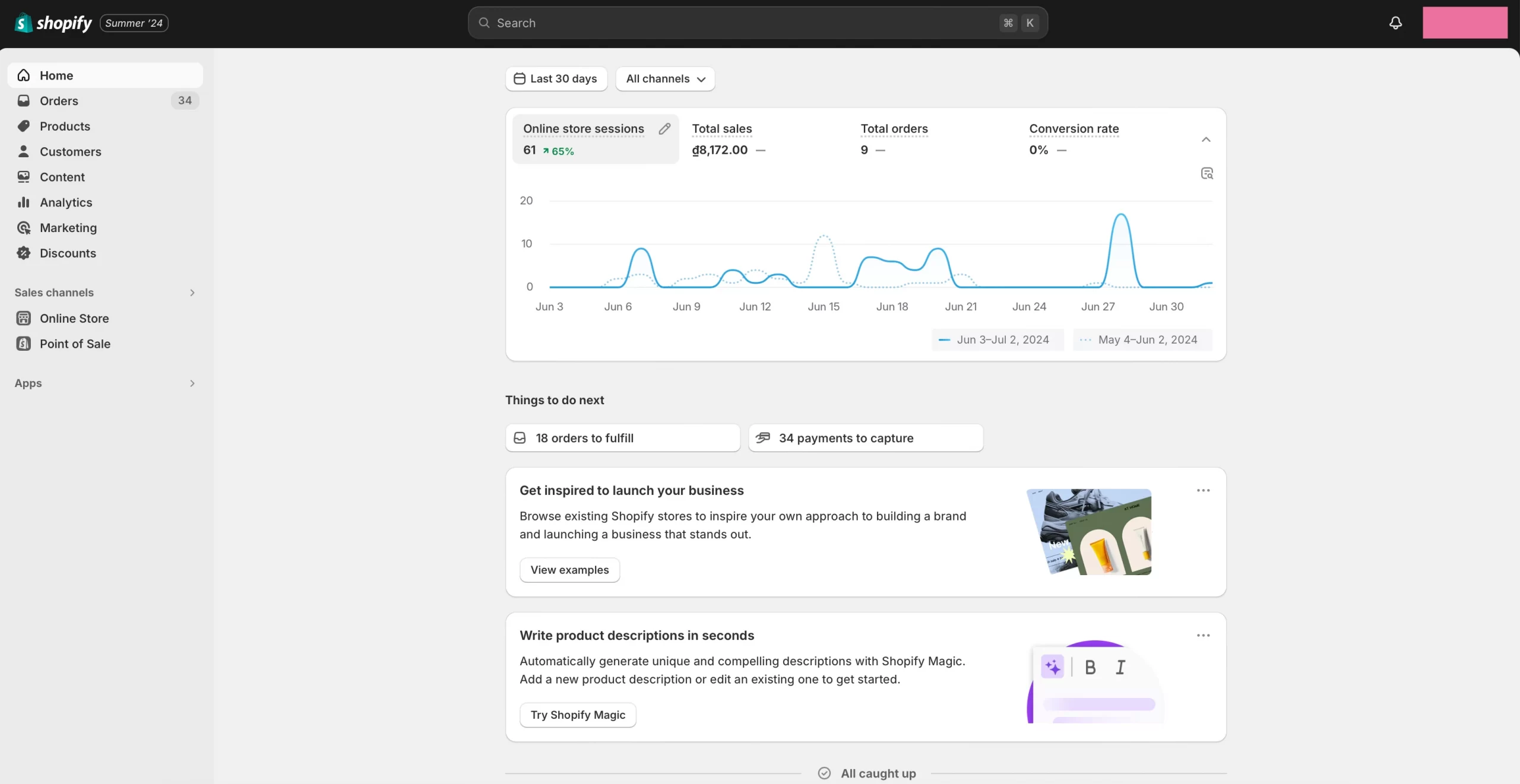
Additionally, Shopify is built for everyone, both tech-savvy and people with a little technical background. As a result, I don't have much trouble while building my online store on Shopify.
Yet, I must admit that with Shopify, some advanced customizations are restricted to what the platform and its apps support. Shopify’s app-driven approach suits small businesses looking for quick, manageable solutions, but it lacks the depth of control Magento offers. Magento is the platform of choice for businesses with unique requirements that need full ownership over their site’s architecture.
The verdict:
It's clear to me that Shopify wins in this Magento 2 vs Shopify battle. Being easier to use than Magento, Shopify is the perfect choice for those who lack technical knowledge.
Best for Apps & Extensions: Shopify
Themes only make up the look and feel of your website. However, to add additional functionality, adding extensions is a solution for you. Both Adobe Commerce Cloud vs Shopify offer app stores and extensions. Most of these applications are just a click away, allowing you to add multiple features to your eCommerce site.
Magento Extensions
At the moment, Magento provides nearly 4400+ extensions through the Magento marketplace. While there are user-friendly methods to install extensions (such as using the web setup wizard), many installations, particularly those involving custom or complex extensions, require some level of technical knowledge. For example, users often need to utilize Composer or perform command-line operations (e.g., running commands like php bin/magento setup:upgrade), which do require basic familiarity with coding and server management
As I looked through the list, I found that some highlight extensions are extremely helpful. For example, Mageplaza allows me to promote products by providing them with custom discount options or using plugins. Product Pre-Order can automatically email potential customers whenever a new product is available.
I also want to mention an Adobe Exchange Partner, Magezon. They provide quality and trusted Magento Extensions such as Magezon Builder (the key product package) and many free products.
Shopify Apps
Compared to Magento, Shopify App Store provides over 8000+ free and paid apps to add features, control your store, and boost sales. If you are on a low budget like me, even free ones are satisfying enough. However, it's worth noting that while many apps offer free tiers, some may have limitations or require paid upgrades for full functionality.
For example, Avada SEO can aid your SEO efforts, PageFly is the best website builder app, and Dsers is the go-to app if you want to start dropshipping on your site.
The verdict:
Between Shopify versus Magento, Shopify won my heart regarding the number of apps and extensions compared to Magento.
Best for Marketing Features & SEO: Shopify
In these Shopify vs Magento comparisons, we will mainly focus on comparing their SEO and other sales features.
Magento marketing features & sales tools
SEO stands for Search Engine Optimization allows you to optimize your eCommerce website SEO as this will affect your store ranking. This is an aspect in the Magento vs Shopify comparison in which both the shopping carts offer pretty similar options.
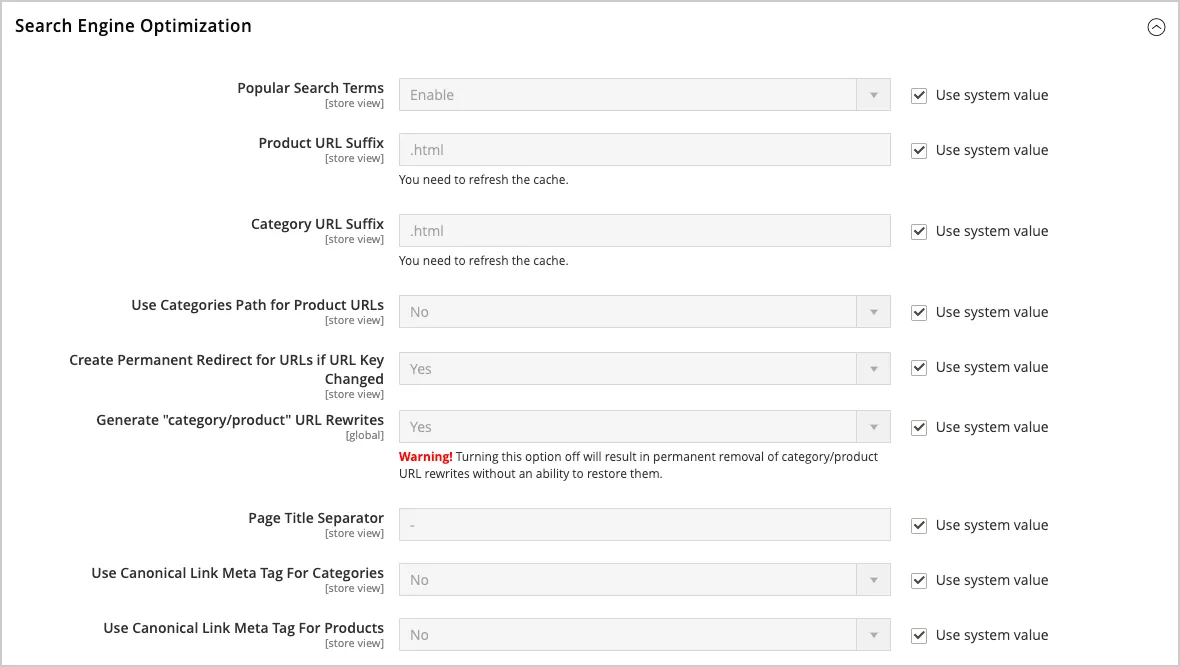
On Magento SEO, I can easily edit the page title and description to define how my store displays in the search results pages and add alt text to images to help search engines understand what they are all about. For more details, you can have a look at this Magento SEO guide to rank your online store better on Google.
Other marketing features
Magento comes with a powerful set of marketing features to promote your online business. For example, Magento allows users to create flexible coupons for multiple purposes freely, create a landing page for different categories, or manage newsletters. You can also set discounts on items for abandoned cart recovery.
When it comes to multi-channel selling options, you can integrate your eStore with Facebook, Instagram, and eBay by installing extensions.
Shopify marketing features & sales tools
Shopify's SEO features include automatically generated sitemaps, editable meta tags, and alt text for images, along with a clean URL structure. However, Shopify’s URL structure is limited to predefined formats, such as /products/.
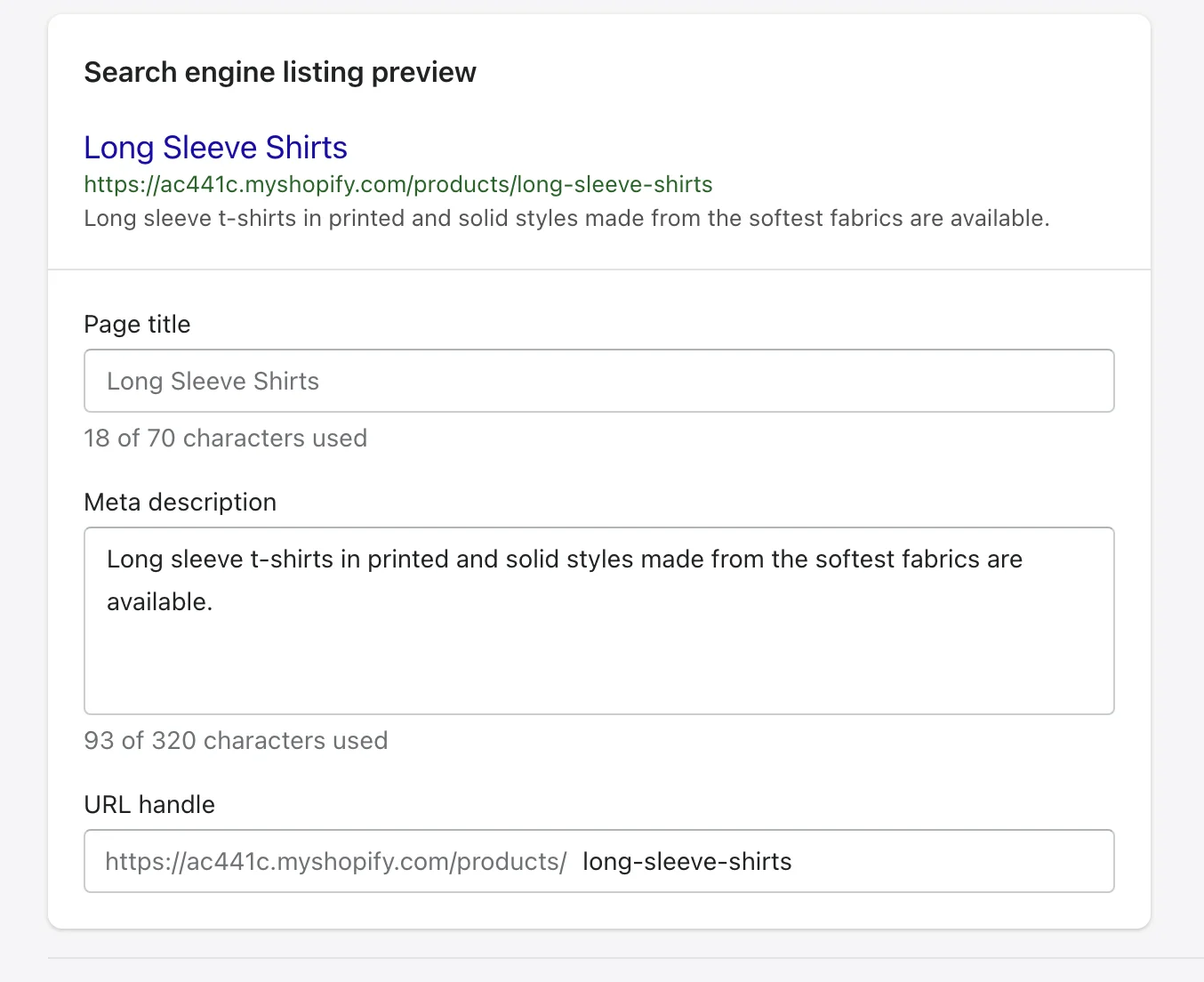
To extend SEO possibilities, you can buy more SEO apps in the Shopify App Store. For example, SEO Booster is a Shopify app that allows users to find issues related to SEO as soon as possible and solve them on time.
Other marketing features
On the marketing side, Shopify provides built-in email marketing and abandoned cart recovery tools.

With Shopify Email, you can create emails tailored to your brand with a plethora of stunning email templates to customize but can still maintain professionalism.
Regarding Shopify's social media marketing, you can share your products to key social media channels like Facebook, Twitter, Reddit, LinkedIn, or Pinterest. Shopify has Shopify Collabs, which allows you to partner with creators or KOLs to promote your business.
The verdict:
Personally, Shopify takes the prize. Both Magento vs Shopify rely on app markets for the most significant marketing functions, but Shopify includes social media advertising as a built-in feature.
Best for Payment Options & Transaction Fees: Shopify
Shopify Payment Options & Transaction Fees
Payment options
During my setup process, Shopify offers more than 100 payment gateways, but I need to pay specific fees.
Credit card processing fees
Your payment provider will charge you a fee for completing all transactions, including data transmission between buyers and sellers, issuing banks, and acquiring banks. In my case, I was charged based on the Shopify Plan I chose.
Shopify charges you a specific fee for each online transaction based on your chosen plan.
- Basic Shopify: 2.9% + 30¢ USD
- Shopify: 2.7% + 30¢ USD
- Advanced Shopify: 2.5% + 30¢ USD
- Shopify Plus: custom
Transaction fees
To save the cost for e-merchants, Shopify also has a payment processor that is friendly to use called Shopify Payments, and it’s definitely free. On the other hand, if customers use Shop Pay, they can enjoy a free transaction!
Magento Payment Options & Transaction Fees
Payment options
On the other hand, Magento doesn’t have Magento Payment, which means I have to download the payment processor's extension through the Magento marketplace and then pay a transaction fee for it. At present, Magento provides 200+ checkout enhancement options.
Transaction fees
For example, if you choose PayPal as your Magento payment gateway, PayPal will charge you 3.49% + $0.49 for every transaction processed within the US and 5.0% for international cards (with no setup or monthly fee).
Moreover, Magento's payment apps support different languages, so if you want to conquer the world's eCommerce business, multi-language support is essential.
The verdict:
When it comes to Shopify vs Magento payment fees, Shopify is the better choice. E-merchants who use Shopify Payments or Shop Pay can use a free transaction.
Best for Reports & Analytics: A Tie
When you're owning or are about to start an eCommerce business, tracking store performance is rather important. So, I must mention reports and analytics when comparing Magento vs Shopify.
Shopify reports & analytics
Shopify provides a range of reporting and analytics features to help merchants gain insights into online stores' performance, customer behavior, and sales trends. These features enable users to make data-driven decisions and optimize their businesses.
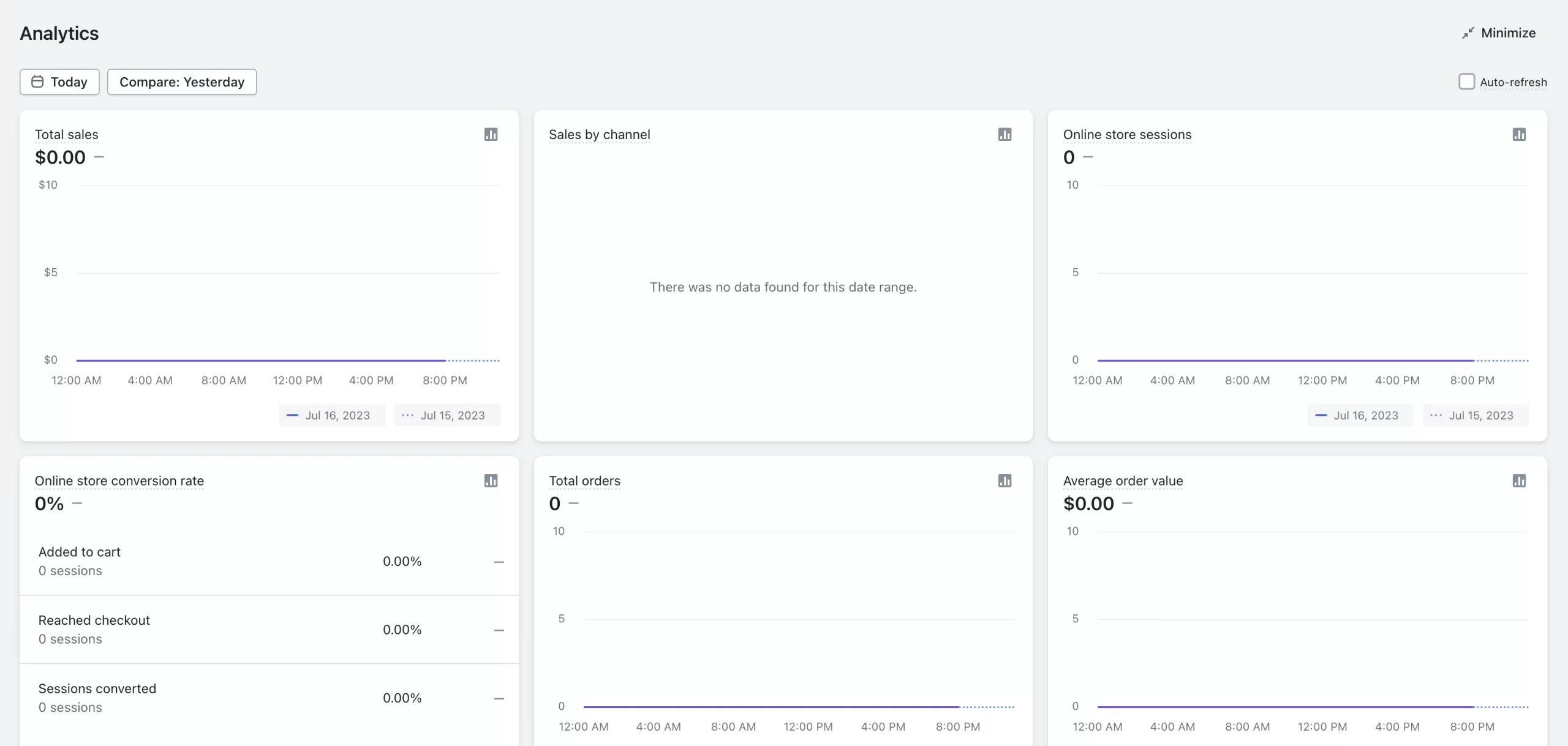
Within Shopify Analytics dashboard, you may gain insights in:
- Reports. Begin by choosing a report template, which can be modified later by adjusting the columns and filters once your custom report is created.
- Live view. You may track your store's current Orders or Visitors with Total sessions.
What is more, Shopify also allows you to integrate Google Analytics into Shopify store for further tracking insights.
Magento reports & analytics
Magento 2's specific reporting and analytics capabilities may vary depending on the version, extensions, and integrations you're using.
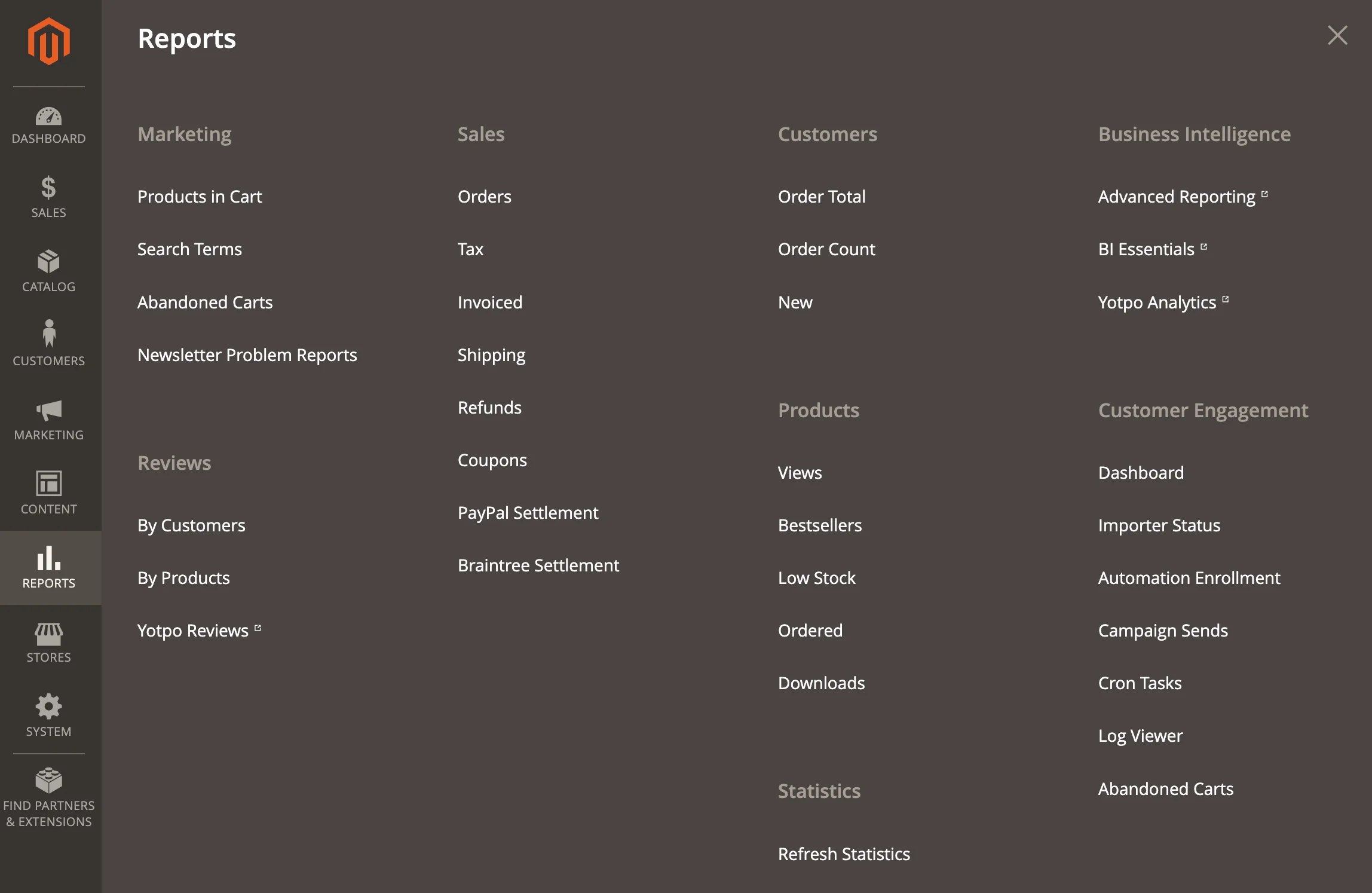
For example, here are some key features of reporting and analytics in Adobe Commerce (Magento 2):
- Sales & Customers tracking.
- Review tracking and more.
Magento also lets you integrate with Google Analytics 4 to your store for further analytics and tracking.
The verdict:
When it comes to Shopify vs Magento analytics, it seems to be tight since both platforms offer sufficient analytics features!
Best for Help & Support: Shopify
Shopify Support
It is obvious that I will run into problems while trying to build my online store. And I must say, Shopify offers the most dedicated help and support. No matter where you are from or what time it is, there will always be a professional team working 24/7 to solve your problem in a minute. I can either contact them via phone, email, or even live chat as long as it benefits me.
Not to mention their supportive community forums, help center, API documentation, and numerous video tutorials. Even if that still does not satisfy you, feel free to hire professional certified Shopify experts to ensure maximum problem resolution and flawless business operation.
Magento Support
Being a self-hosted solution, Magento doesn’t offer live chat, phone, or email support along the way unless you register for the Magento Commerce Cloud plan for B2B. Because of this, there are parts where I feel pretty exhausted while trying to build my own Magento store.
However, you can still benefit from Magento's excellent user community. You can receive informative advice from Magento experts all around the globe. Besides that, there is an active help center that provides all-time support as in the image below:
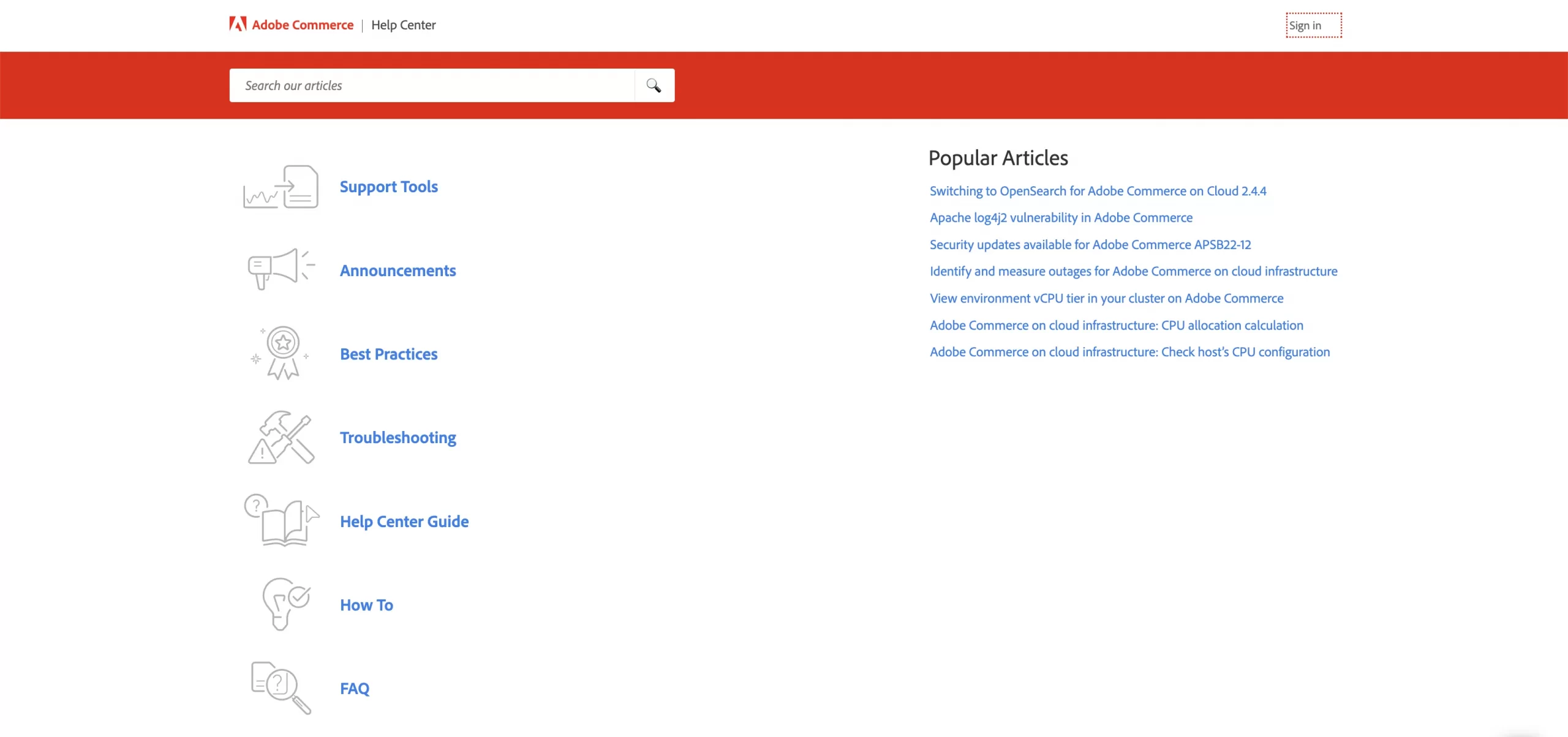
The verdict:
If you ask me, Shopify is the clear winner here when it comes to Shopify vs Adobe Commerce support. This eCommerce platform provides excellent customer services, including phone, email, and live chat support, while Magento has an international community to help you solve your issues.
Best for Other Functionalities: Magento
 |  | |
Dropshipping | Only 10+ dropshipping extensions on Magento Commerce Marketplace. | 100+ Shopify dropshipping apps on Shopify App Store. |
Provisions for coupons | Magento allows discount code creation and calculation functionalities from the start. | This feature is available on every plan apart from the Starter one. |
Shipping | Major shipping carriers like USPS, UPS, DHL & FedEx. | Built-in Shopify Shipping with major shipping carriers like DHL, USPS, UPS, FedEx, Canada Post, Sendle.... |
Multilingual capabilities | Multi-lingual capacities. | Third-party/paid apps are available for Shopify for this. It does not offer full multilingual capabilities by default. |
Currencies | Magento supports currencies from over 200 countries around the world. | 135 currencies supported. |
Scalability | Magento offers massive flexibility and scalability. Also, it can cope with high levels of traffic. | Shopify is proper for both newcomers and big sellers. You can upgrade your store plan to Shopify Plus for an enterprise level. |
Security | Magento does give its users the flexibility to improve store security by themselves. Otherwise, you can install the Magento extension in the Payment & Security section to keep the business data safe. | Shopify is a hosted solution coming with Fraud analysis, PCI Compliant, GDPR Compliant and SSL Certificates available for every Shopify sites. |
The verdict:
From my standpoint, Magento outperforms Shopify in terms of functionalities such as multilingual capabilities or sales tools. Based on my experience, many of your business objectives and demands will require you to look for and use functions on Magento.
Addressing Adobe Commerce vs. Shopify Limitations
Magento’s Limitations and Adaptations
Magento’s most notable limitation is its complexity, which can be daunting for beginners or businesses without technical expertise. Unlike Shopify, Magento requires coding knowledge for setup, customization, and maintenance. However, the platform has made strides in addressing this challenge by offering improved documentation, tutorials, and a robust developer community. These resources make it easier for users to navigate Magento’s features and leverage its flexibility effectively.
Another challenge with Magento is that it’s resource-intensive, requiring powerful hosting solutions to ensure optimal performance. For businesses without the infrastructure to manage this, Magento’s self-hosted model can be costly and time-consuming. To alleviate this issue, Adobe Commerce (Magento’s enterprise edition) provides cloud hosting solutions, streamlining infrastructure management and ensuring scalability for larger operations.
Shopify’s Limitations and Adaptations
One of Shopify’s primary limitations is its restricted backend customization. As a closed-source platform, Shopify doesn’t allow users to alter its core functionalities or make extensive modifications to the backend architecture. This can pose challenges for businesses with highly specific requirements.
To address this, Shopify provides an extensive app marketplace, offering a wide array of tools and plugins that extend the platform’s functionality. These apps allow businesses to customize their stores without needing access to backend code, making Shopify an adaptable choice for users with limited technical expertise.
Another common concern with Shopify is its variant limit, which restricts each product to a maximum of 100 variants with three customizable options (e.g., size, color, material). This can be a significant drawback for businesses with complex or highly customizable products.
Shopify mitigates this limitation through third-party apps like Infinite Options, which enable users to bypass these restrictions and offer greater customization to their customers.
Editor's thoughts: Shopify and Magento each handle their limitations in helpful ways. Shopify Plus is a strong option for larger businesses that need speed and managed services. In contrast, Magento allows for more customization, making it suitable for enterprises that have specific needs for flexibility and scalability.
Magento vs Shopify – Summary
To sum up, the analysis above showed you the key similarities and difference between Magento and Shopify that I concluded when I ran my business on both platforms.
So, why use Magento? Overall, Magento is ideal for:
- Businesses with large catalogs, high traffic volumes, and complex needs.
- Businesses with technical expertise.
- Magento offers more flexibility than Shopify for those who need complete control over your online store's features and functionality.
Shopify is ideal for:
- Businesses of all sizes but with less customization than Magento.
- Businesses prioritize ease of use rather than needing technical expertise to set up and manage.
- Shopify's streamlined setup process lets users get online stores up and running quickly.
Ultimately, the best platform for your business depends on your specific needs, budget, and technical expertise. You should research and evaluate both Shopify Magento thoroughly before making a decision.
Selling on eCommerce platforms and online marketplaces like eBay, Amazon, or Etsy can also drive more sales and connect thousands of buyers outside of these.
If you want to grow your business with multi-channel selling, how about trying LitCommerce? For more details, this tool is another LitCommerce brand that will help you automate repetitive processes and take control of everything from a central dashboard.
My Methodology
To give you the most honest and actionable Magento vs Shopify comparison, I rolled up my sleeves and tested both platforms like a real store owner:
Step 1. Built real test stores on both Shopify vs Magento
First, I created three fully functional demo stores: one on Magento Open Source (hosted on a private server with cPanel and Composer) and one using Shopify's Basic and Advanced plans.
After that, just like a typical store owner would, I also went through every step of setting up a store: installing themes, adding products, configuring payments, and testing checkout flows. That's how I saw firsthand how intuitive (or not) each platform really is!
Step 2. Put core features through real business scenarios
Next, using the nine business-critical criteria above, I tested how each platform performs under real-world conditions. For SEO, for instance, I tweaked meta tags, ran structure audits, and tested mobile optimization with tools like Google PageSpeed. I also tested built-in tools and extensions for marketing, dropshipping, reporting, and any similar feature that actually impacts your day-to-day operations.
Step 3. Calculated the full cost of ownership, not just surface prices
Rather than just listing subscription fees, I built out three business scenarios: a startup, a mid-sized store, and a large enterprise.
Then, I calculated the real costs: themes, apps, hosting (for Magento), developer support, transaction fees, and everything in between. As you can see in the detailed breakdown above, Magento's “free to download” isn't as free as it sounds once you scale up!
Step 4. Cross-checked findings with real merchants and experts
Lastly, to make sure my Shopify vs Magento verdict wasn't biased, I explored Shopify Community threads, Magento forums, Reddit discussions, and G2 reviews to look for recurring pain points and workarounds. On top of that, I also spoke with certified Shopify developers and Adobe Commerce partners to get a professional take on how each platform performs at scale or with unique customization needs.
Magento vs Shopify – FAQs
Which is better, Magento or Shopify?
Shopify and Magento are the top eCommerce platforms in the market. While Magento is an open-source solution that grants users complete control over their site, Shopify is a hosted platform that provides an all-in-one service to build your online business.
Is Magento the best eCommerce platform?
For our part, Magento is a good platform to build your online business. For more specific, it is packed with powerful eCommerce features to help you step up your business game.
Why do people still use Magento?
Magento's open-source nature allows for extensive customization and flexibility, making it ideal for handling high traffic and transactions. While it may have higher upfront costs, it can be more cost-effective in the long run for large businesses.
What is the new name for Magento?
Magento has not been completely renamed, but its enterprise edition is now officially called Adobe Commerce. The open-source edition, previously known as Magento Open Source, retains its name.
However, since Adobe's acquisition of Magento, the term "Adobe Commerce" is becoming more widely used to refer to the platform as a whole.
Why migrate from Shopify to Magento?
Migrating from Shopify to Magento is the right move if your business needs advanced custom features and deeper backend control to handle a large product catalog with complex variations. And with LitExtension’s Shopify to Magento Migration service, the transition is frictionless — no data loss, no headaches, just a smooth path to a more powerful store!
Bottom Line
In conclusion, I rated Shopify higher in comparison vs Magento, but this is still my subjective assessment based on the analysis. Therefore, I highly recommend you find out which one, Magento vs Shopify, is suitable for you by prioritizing the important criteria before making a final decision.
Finally, if you feel dissatisfied with your current shopping cart and wish to migrate to a new dream shopping cart, LitExtension – #1 Shopping Cart Migration Expert can still help you migrate data from the source store to the target store. It is designed for all users and requires no technical or programming skills.
Last but not least, don't forget to check out LitExtension blog and join the Facebook Community to get more Magento Shopify tips and news.

